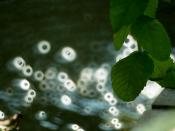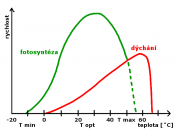Introduction:
Photosynthesis and respiration are key components of plant and animal life. Both rely on each other: plants provide animals with the oxygen they need to survive, while animals help provide some of the carbon dioxide necessary for plants. Since photosynthesis and respiration impact so many organisms, it is important to know the optimal conditions each process works in.
Plants receive the energy they need to perform photosynthesis by absorbing light. Light energy has the ability to excite electrons. These electrons move through a transport chain and are converted to different electron receptor molecules. These molecules then go through respiration to produce glucose and ATP. Not all wavelengths of light possess the same amount of energy though. In the visible spectrum, red light contains the least amount of energy, while violet light contains the most (Klein, 1992). The more energy a particular wavelength possesses, the better it is at exciting electrons and progressing the rate of photosynthesis (Humphrey, 1983).
Cellular respiration depends on photosynthesis. Respiration relies on photosynthesis to supply it with glucose to convert to ATP. This process consists of multiple parts including glycolysis, the citric acid cycle, and the electron transport chain. It has been shown that like photosynthesis, cellular respiration can also be affected by light (Robertson et al., 2013). One way in which light can affect respiration is by dictating the amount of glucose available for glycolysis, which is the breakdown of glucose. This occurs by regulating the amount of glucose that is made during photosynthesis.
All plants undergo photosynthesis, including aquatic plants. Elodea densa is an aquatic plant that tends to grow in warm, shallow waters (Riis et al., 2012). Just like any other plant, E. densa is subject to a variety of factors that can effects how it photosynthesizes, and by extension,


